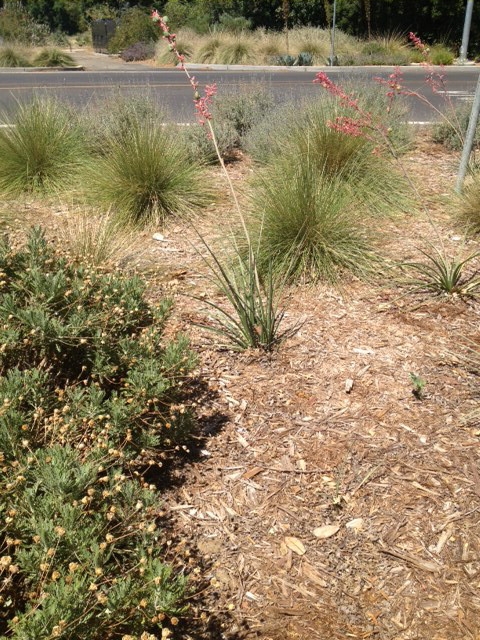Make a Nice Impression
As I have been to the UC Davis campus quite a bit in the last month, I have really appreciated how thoughtfully the landscaping has been designed and maintained. There is an abundance of bush roses, many ornamental grasses and so many different trees, it is a bit overwhelming. In the last couple of weeks, one particular plant has caught my attention more than once. I finally stopped my car the other day, and got out and photographed the plant. Later on that same day, I happened to be walking by a stunning border of very healthy perennials and there it was again. Fortunately for me, this specimen had a label. It sure is nice to run across a designed garden space where someone(s) has taken the time to label each and every plant with both the botanical and common names. Thank you, UC Davis Arboretum staff.
My mystery plant is Hesperaloe parviflora, commonly known as Red Yucca, although this plant is not a yucca at all. It happens, that at the moment, I am trying to better understand more about yuccas in general, so perhaps that is why I was attracted to this plant, but that will be another story. This Red Yucca has flowers that are not really red either. They are really more of a warm rose-coral color. An additional confusion: online sources, the Native Plant Database and the Texas Native Shrub database, both listed this plant as a member of the Agavaceae Family (Century Plant Family) with many common names including: Red Yucca, Coral Yucca, Red flowered false yucca, Redflower false yucca, Samandoque, and Yellow yucca. However, the newest Sunset Western Garden Book listed this plant in the Asparagaceae family. My Wait Manual unfortunately doesn’t list this plant at all. So, I will do some more checking down the road.
Although my sources don’t seem to agree on a family grouping, they do agree that it is not a yucca although it shares many physical characteristics of a yucca. In general, the yucca is described as producing huge clusters of bell-shaped flowers above upright, sword-like leathery leaves in large evergreen rosettes. The Red yucca produces soft, yucca-like, evergreen leaves, 2 to 3 feet in length, crowded on a short woody base. The flower stalk extends to 5 feet above the leaves with a clustering of coral tubular flower on arching, pink stems. The leaves are plum colored in winter and blue-green during the rest of the year. The leaves are simple and linear with parallel venation and form a basal rosette. It blooms March through July. This plant is drought resistant and both heat and cold tolerant as well as adaptable to a variety of soils. I can say from my observations that these plants are hummingbird magnets. The coral color is very cheerful and adds a nice breezy touch to a mostly green landscape. Sunset recommends these plants as good container specimens and I may just take them up on that suggestion next to my newly espaliered bougainvillea. What a nice impression that could be next summer.

Hesperaloe parviflora. (photo by Trish Rose)

